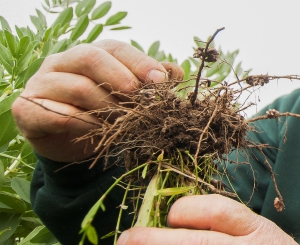
Key points
- Improvements in nitrogen fixation can be achieved with small adjustments in inoculation techniques
- Paddock history and soil condition (e.g. pH) are important when deciding whether to inoculate
- Inoculants consist of living organisms (rhizobia), and exposure to dehydrating or toxic conditions reduces survival and effectiveness
Growers seeking to boost nitrogen fixation while growing pulses this season are being encouraged to review their inoculation practices.
Researchers working on a Grains Research and Development Corporation (GRDC) investment, aiming to improve nitrogen fixation in pulses, believe growers could be missing out on the full benefits of correctly inoculated pulses.
Adelaide University School of Agriculture, Food and Wine Research Associate, Maarten Ryder, says when deciding whether to inoculate or not, some key factors include the time since the last legume crop was grown in a particular paddock, how successfully did that crop nodulate and soil acidity.
Legume inoculants contain living rhizobia that must be handled and applied carefully to ensure good nodulation and nitrogen fixation by the crop or pasture.
The GRDC’s Inoculating legumes: The Back Pocket Guide (www.grdc.com.au/GRDC-BPG-InoculatingLegumes) can help growers navigate these issues such as crop types, nodulation assessment and information on the likelihood of crop response to inoculation.
For growers seeking a more detailed resource, Inoculating Legumes: A practical guide (https://grdc.com.au/GRDC-Booklet-InoculatingLegumes) provides insight into legumes and nodulation and how to effectively use inoculation as a key farm practice.
To help guide growers through inoculation, Dr Ryder has put together 10 dos and don’ts of legume inoculation:
DO
1. DO take into account paddock history
Crop type, legume type and time since previous inoculation can affect the decision to inoculate. In ideal conditions, rhizobia can survive in the soil for several seasons. However, acidic soils with a pH of less than 5.5 measured in calcium chloride can reduce the survival of rhizobia for most legumes. In such acidic conditions, most legumes will require inoculation each time the crop is grown.
2. DO use the correct inoculant group for the legume
Inoculant groups contain rhizobia that are specific to each legume type. Using the correct group for the type is vital to good nodulation and nitrogen fixation, and nodulation failure will occur if the wrong group is used.

1 Both inoculant groups G and S can be used for lupin and serradella.
2 Commercial inoculant is generally group F, which is routinely used for all four grain legumes in the E/F group.
Source: Inoculating Legumes: A Practical Guide https://grdc.com.au/__data/assets/pdf_file/0020/82082/grdc-booklet-inoculating-legumes.pdf.pdf
3. DO take care when inoculating pickled seed
Some pickles, or seed-applied fungicides can reduce the survival of the rhizobia on the seed. For example, thiram and fungicides containing thiram (P-Pickel T®) are toxic to rhizobia and metalaxyl (Apron®) can also be inhibitory.
To avoid issues of this type, inoculants can be applied as granule or liquid/slurry in a furrow separated from the seed. If inoculating seed over the top of an inhibitory seed fungicide, sow as soon as possible to minimise exposure time (ideally within six hours).
4. DO consider using double rate inoculant in the following situations:
5. DO use clean equipment and containers or tanks
Rhizobia are sensitive to chemical and fertiliser residues, especially herbicide residues. Take care to use clean equipment thoroughly when preparing, mixing and delivering inoculants.
DON’T
1. DON’T use very saline bore water or highly chlorinated water when preparing and applying peat slurry or freeze-dried inoculants
Use potable (drinkable) water. Allow chlorinated tap water to stand in an open tub overnight to allow chlorine to disperse.
2. DON’T mix trace elements with liquid inoculant as they can be very toxic to rhizobia
Rhizobia may not survive well in tank mixes with some trace elements, such as zinc and copper, and other fertilisers. For seed inoculation, the better options are separate in-furrow liquid application or granular inoculants. Seed coatings with trace elements and followed by inoculation can also be problematic for survival of rhizobia.
3. DON’T wait too long before sowing inoculated seed
Sow within 24 hours, or sooner if coating inoculant on to seed over some types of pickle or trace element coatings.

* Sow as soon as possible, within 6 hours.
4. DON’T leave inoculant packets or inoculated seed in direct sunlight or in temperatures higher than 25 degrees Celsius.
Warm to hot temperatures can have negative effects on rhizobia organisms as they have little heat tolerance. This applies to all types of inoculant in bags or packets, on inoculated seed, as liquid for furrow application or as granules.
5. DON’T mix inoculants directly with fertilisers.
Some types of fertiliser can be toxic to rhizobia. Inoculated seed should not be left in direct contact with fertiliser for extended periods. This is particularly the case for acidic fertilisers such as mono ammonium phosphate (MAP) and super-phosphate.







